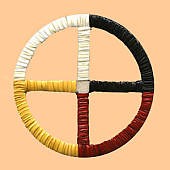The inclusion of this scene is
necessary to understand that cheating can become cyclical. The
French tradesman boasted about how great of a cheater he was, but it
was not until a man on the street told him of Iktomi. Iktomi was
said to be the best cheater there was, he could steal anything from
you without you even knowing. He was as witty as they came and it is
because of his modest attitude that he was able to get away with
these sneaky deeds. However, in life there will always be someone
better than you at everything no matter how good you are at
something. Iktomi faces this problem as he rides off into the
horizon.
As Iktomi rides off into the horizon
with his newly acquired horse, jacket, hat, and boots, the French man
screams, “Sacre Bleu.”
Iktomi removes his jacket to reveal his
backside back to the French man and sticks out his tongue to prove
that he was tricked. This is when Iktomi makes the mistake of his
cheating career. It is at this moment where Ikto bends down to
unveil his jacket that the horse is spooked. He begins to kick and
flail as he notices that it is not his French owner. Ikto is thrown
to the ground during which his horse runs off. The horse runs off
out of sight while Ikto is forced to walk back to the town towards
the French man.
When Ikto reached the town the French
man was the first to greet him.
“I see you have returned without my
horse.” The French man said.
Ikto was rather embarrassed, but
confidently remarks, “Yea, I realized if you and I were to team up
and work together we could cheat the entire world.” Confused by
Ikto's reply the trader hesitates a minute and decides that this
will be a great idea. The first trick they decided to do was get a
ride from these two men on horses. They get these two men's
attention and they come over to speak to Ikto and the trader. The
men ask, “What can I help you with?”
“Well, we just need a ride to our
place, can you do that for us?” The two men reply, “Sure, we
just need you to remove all of your clothing except underwear so we
know you do not have any weapons.” As both of the men strip down
to their underwear and put their clothes in the bag at the back of
the horse, the two men look at each other with a coy smile. With
the kick of their legs the horse gallops away with all of their
belongings. They trot off with elegance and grace and yell back to
the two fools, “Maybe next time you will not cheat others.”
Little did these two know these two men were watching these two from
the beginning. He watched Ikto cheat the trader.






